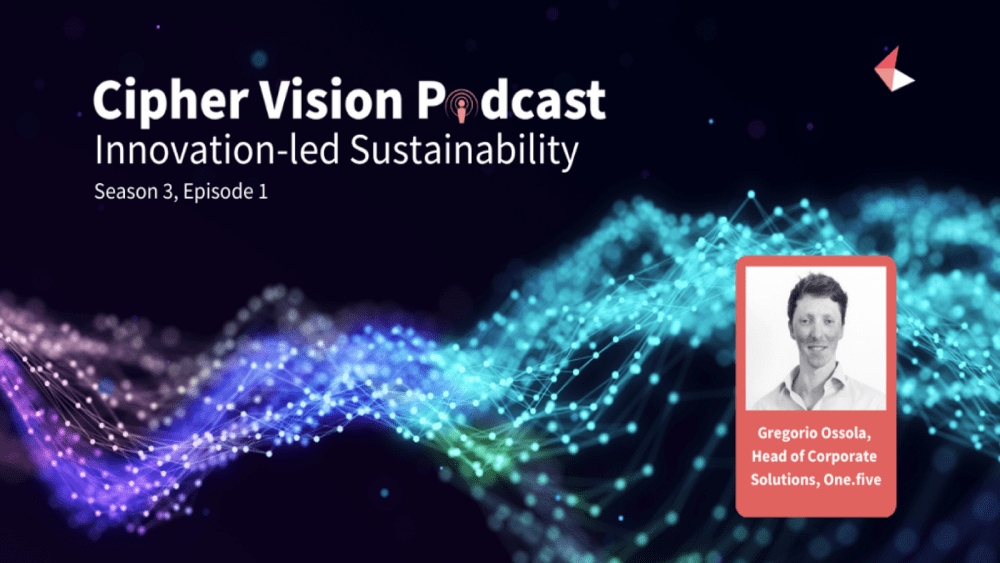Innovation-led Sustainability

Introduction
Episode 1 in Season 3 of the Cipher Vision Podcast series features Gregorio Ossola, Head of Corporate Solutions at one.five.
He shared with us the data-led approach that one.five is taking to revolutionise the sustainable packaging industry.
These steps included utilizing a convergence of sources, including patent intelligence and consumer preferences to make fully-informed decisions on which materials will lead the way to a more green future.
He chats to the hosts of the Cipher Vision podcast, who are:
- Francesca Levoir, Head of Marketing, LexisNexis Cipher
- Nigel Swycher, CEO, LexisNexis Cipher
Conversation highlights
On one.five’s mission
One.five is effectively a biomaterials, research, development and scale-up company.
And the reason why I mentioned all three of these elements is because we don’t just focus on the initial stages of innovation and development, or we don’t just focus on the scale-up and the commercialization of products, we look at the entire spectrum.
Our business model is to patent develop technologies and licence them out in various different forms to our customers, that are mostly within the consumer packaged goods space.
What we want to do is enable change in the packaging industry and brands alike, with tried and tested blueprints to make sustainable packaging.
On forging blueprints for sustainable packaging
Take the example of a CPG company that say, produces ground coffee.
What we will do is effectively take their performance needs, their criteria, we would look for relevant IP and technologies that can fulfil this need, and then develop it from prototype scale all the way to mass production.
Creating effectively a blueprint that this company needs to follow to produce. And what we try to do is to integrate within their supply chain.
The obstacle facing large corporations
There are much larger companies with much deeper pockets than we could ever imagine, that have access to an incredible amounts of tools. The reality is that the perfect technology, or say the most sustainable technology, currently does not exist.
There may be bits and pieces here and there that combined give you the perfect sustainable packaging. But the perfect solution is not out there, despite the claims of the industry.
And this is where one.five is trying to disrupt the industry.
We’re looking at a completely different approach to innovation, which does not stop only at performance properties and functionalities of material or a technology.
We’re looking at the entire spectrum of criteria that are crucial to bring that technology from ideation, all the way into commercial availability.
There’s no point in having the perfect technology, the most sustainable technology, if nobody then uses it.
And this is why it’s crucial for us to bring technologies from early development all the way to commercialization. That’s really the only way that you can have positive impact on the environment.
The convergence of data for impact
What we’re doing is we are cross-matching client briefs or client datasets with patent data and potentially unpublished technologies.
But what we do on top of that, is we overlay a series of others’ datasets such as environmental and sustainability criteria, consumer acceptance data, material science parameters, and economic and commercial criteria that all help us to inform our decisions.
So we’re essentially looking at the entire value chain of innovation. We’re combining datasets to assess a technology across their entire lifespan, such that it has the highest chance of making it to market.
On adopting a holistic approach to data
Let’s take the example that we we found the best performing plastic in the world.
It has the perfect functionalities: it fits perfectly, will store your ground coffee that we referred to previously for 24 months or 36 months, it’s just a fantastic product.
And maybe it ticks the box from a sustainability perspective because it has the lowest carbon footprint in the market. But if we look at current market conditions, plastic has a very bad reputation with consumers.
So who are the end consumers, would they buy?
We really need to take a very holistic approach to sustainable packaging innovation, to make sure that it is the right material, it has the right functionalities and is also then used for the purpose it was intended to at scale.



